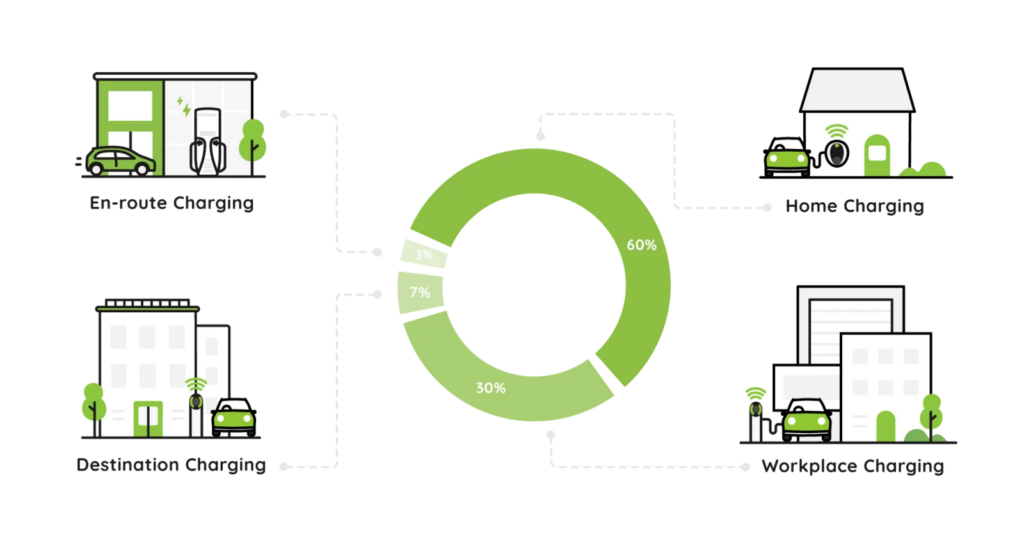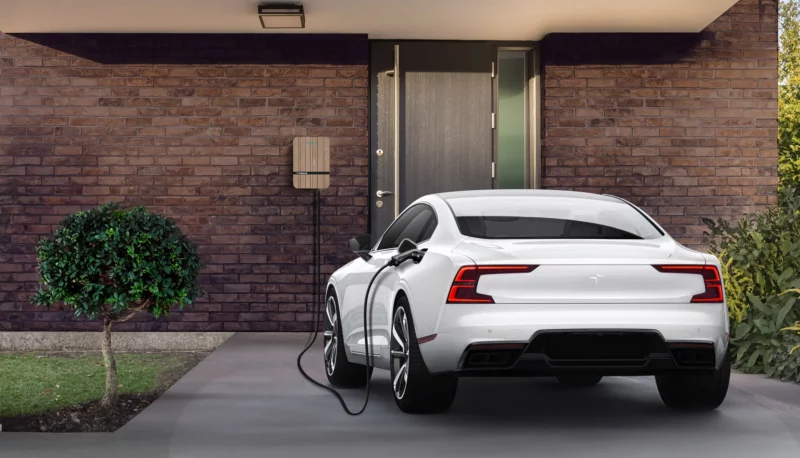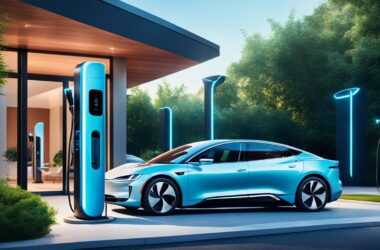Exploring the UK’s Electric Vehicle Charging Landscape – electric charging points
Electric vehicles (EVs) have revolutionized transportation, offering a cleaner and more sustainable alternative to traditional petrol and diesel vehicles. Central to the widespread adoption of EVs is the availability of efficient and accessible charging infrastructure and electric charging points. In this comprehensive guide, we delve into the intricate workings of the UK’s electric vehicle charging ecosystem, exploring various charging methods, locations, costs, and considerations for drivers and businesses alike.
Understanding the UK Charging Ecosystem
The charging ecosystem for electric vehicles in the UK operates on a fundamentally different premise compared to conventional petrol or diesel refueling. Unlike the traditional model of driving to a service station for a quick fill-up, electric car charging is a more nuanced process. It encompasses a diverse array of charging locations, each catering to different needs and charging requirements.

Charging Locations and Infrastructure
Electric car chargepoints can be installed in a multitude of locations, ranging from residential settings to public spaces and workplaces. Unlike traditional fuel stations, where one must drive specifically to refuel, EV chargepoints can be integrated seamlessly into everyday environments. This versatility stems from the fact that chargepoints require only sufficient electrical power availability, enabling installations in various settings.
One notable aspect of the UK’s charging infrastructure is the prevalence of lower-powered EV chargers in locations where drivers typically spend extended periods. For instance, many workplaces, supermarkets, shopping centers, and other public destinations now feature relatively lower-powered EV chargers. This strategic placement allows drivers to replenish their vehicle’s battery while engaged in other activities, ensuring a fuller battery upon returning to their vehicle.
Additionally, en-route charging stations have been established to cater to the needs of drivers embarking on long-distance journeys. These stations are equipped with higher-powered chargers capable of delivering rapid charging, facilitating quicker top-ups during travel breaks. The comprehensive network of charging infrastructure across the UK forms the backbone of the electric vehicle charging ecosystem.
Charging Etiquette and Best Practices
As with any communal resource, adherence to charging etiquette is paramount to ensure equitable access and efficient utilization of chargepoints. Whether charging at a workplace or in a public setting, drivers should follow established guidelines to promote courteous and responsible charging behavior. This includes adhering to designated parking spaces for EV charging, avoiding unnecessary occupancy of chargepoints beyond the required charging duration, and being mindful of other users’ needs.
Optimizing Charging Practices
Efficient charging practices can significantly enhance the convenience and effectiveness of electric vehicle ownership. Rather than waiting for the battery to deplete completely before charging, drivers are encouraged to adopt a proactive approach by charging their vehicles whenever parked. This “Always Be Charging” mentality helps maintain a sufficient battery level for uninterrupted driving experiences.
For longer journeys, planning charging stops strategically can minimize travel disruptions and optimize overall trip efficiency. Quick charging options available at service stations along major routes enable drivers to replenish their vehicle’s battery rapidly, ensuring minimal downtime during extended travels.

Types of Chargepoints and Connectors
Chargepoints come in various configurations, each designed to accommodate different charging needs and vehicle requirements. Some chargepoints feature tethered cables, where the charging cable is permanently attached to the unit. In contrast, others require drivers to use their own charging cables, known as untethered or universal chargepoints.
Electric vehicles utilize different connector types depending on the charging method and speed. Common connectors include Type 1 and Type 2 sockets for slow and fast charging, respectively, while DC rapid charging utilizes connectors such as CHAdeMO or CCS. Understanding the compatibility between chargepoints and vehicle connectors is essential for seamless charging experiences.
Charging Time and Rate
The time required to charge an electric vehicle varies depending on several factors, including the charging rate of the chargepoint, the size of the vehicle’s battery, and the type of connectors used. Home, workplace, and public chargers typically provide charging rates of around 7kW, sufficient for overnight or extended charging sessions.
Rapid chargers, predominantly found at en-route locations like motorway service stations, offer significantly higher charging rates, enabling rapid replenishment of the vehicle’s battery during long-distance journeys. Despite the faster charging rates, rapid chargers are typically not designed to fully charge the vehicle’s battery but rather to provide sufficient charge for continued travel.
Cost of Charging
The cost associated with charging an electric vehicle encompasses various factors, including the location of charging, electricity tariffs, and charging duration. Charging at home typically incurs lower costs, with the average full charge costing approximately £15.10 based on prevailing electricity rates.
Many workplaces offer charging facilities to employees either for free or at subsidized rates, contributing to the overall affordability of electric vehicle ownership. Public charging, particularly at rapid chargers, may involve higher costs, with a 30-minute charge at a typical rapid charger costing around £11. Despite the varying costs, the overall expense of charging an electric vehicle remains competitive compared to traditional fuel-based vehicles.
Charging at Home: Convenience and Efficiency
Charging at home is arguably the most convenient option for electric vehicle owners, provided they have access to dedicated off-street parking. While it is possible to charge an electric vehicle using a standard domestic socket, this method is not recommended due to safety concerns and slower charging rates.
Dedicated home chargepoints offer numerous advantages, including faster charging speeds, enhanced safety features, and potential integration with smart home technologies. By investing in a home chargepoint, electric vehicle owners can streamline their charging routines while ensuring optimal safety and efficiency.
Charging at Work: Supporting Sustainable Commuting
Many businesses recognize the importance of supporting sustainable transportation initiatives and are increasingly offering workplace charging facilities to employees. The UK Government’s Workplace Charging Scheme (WCS) incentivizes businesses to adopt charging infrastructure by providing grants for the installation of chargepoints.
Charging an electric vehicle at the workplace offers several benefits, including the convenience of charging during working hours and reducing reliance on public charging infrastructure. Employers can leverage workplace charging as a tool to attract and retain talent while demonstrating commitment to environmental stewardship.
Commercial EV Charging: Driving Business Opportunities
Businesses have the opportunity to capitalize on the growing demand for electric vehicle charging by offering commercial charging services to the public. Whether through partnerships with existing charging networks or standalone installations, commercial charging facilities can attract customers, generate revenue, and enhance brand visibility.
Public destinations such as supermarkets, shopping centers, train stations, and airports are ideal locations for commercial EV charging, providing drivers with convenient access to charging infrastructure. Various payment methods, including apps, contactless payment, and RFID cards, ensure accessibility and ease of use for EV drivers.
Conclusion
The UK’s electric vehicle charging ecosystem is a testament to the nation’s commitment to sustainable transportation and environmental stewardship. Through a robust network of charging infrastructure spanning residential, commercial, and public locations, electric vehicle adoption continues to grow, driving the transition towards a greener future.
As the EV market evolves and technology advances, the charging landscape will continue to expand and innovate, offering enhanced convenience, efficiency, and affordability for electric vehicle owners and businesses alike. By embracing electric mobility and investing in charging infrastructure, the UK is paving the way towards a cleaner, more sustainable transportation ecosystem.











reddit priligy However, studies are insufficient and some have been performed only in non human models 52